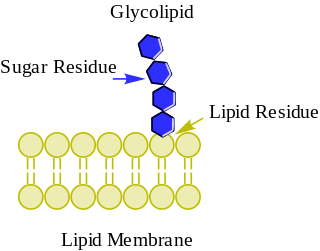
Glycolipids are lipids with a carbohydrate attached by a glycosidic (covalent) bond. Their role is to maintain the stability of the cell membrane and to facilitate cellular recognition, which is crucial to the immune response and in the connections that allow cells to connect to one another to form tissues. Glycolipids are found on the surface of all eukaryotic cell membranes, where they extend from the phospholipid bilayer into the extracellular environment.

Sphingolipids are a class of lipids containing a backbone of sphingoid bases, which are a set of aliphatic amino alcohols that includes sphingosine. They were discovered in brain extracts in the 1870s and were named after the mythological sphinx because of their enigmatic nature. These compounds play important roles in signal transduction and cell recognition. Sphingolipidoses, or disorders of sphingolipid metabolism, have particular impact on neural tissue. A sphingolipid with a terminal hydroxyl group is a ceramide. Other common groups bonded to the terminal oxygen atom include phosphocholine, yielding a sphingomyelin, and various sugar monomers or dimers, yielding cerebrosides and globosides, respectively. Cerebrosides and globosides are collectively known as glycosphingolipids.
Glycosphingolipids are a subtype of glycolipids containing the amino alcohol sphingosine. They may be considered as sphingolipids with an attached carbohydrate. Glycosphingolipids are a group of lipids and are a part of the cell membrane. They consist of a hydrophobic ceramide part and a glycosidically bound carbohydrate part. This oligosaccharide content remains on the outside of the cell membrane where it is important for biological processes such as cell adhesion or cell–cell interactions. Glycosphingolipids play also important role in oncogenesis and ontogenesis.

Cerebrosides (monoglycosylceramides) are a group of glycosphingolipids which are important components of animal muscle and nerve cell membranes.

Lipid signaling, broadly defined, refers to any biological cell signaling event involving a lipid messenger that binds a protein target, such as a receptor, kinase or phosphatase, which in turn mediate the effects of these lipids on specific cellular responses. Lipid signaling is thought to be qualitatively different from other classical signaling paradigms because lipids can freely diffuse through membranes. One consequence of this is that lipid messengers cannot be stored in vesicles prior to release and so are often biosynthesized "on demand" at their intended site of action. As such, many lipid signaling molecules cannot circulate freely in solution but, rather, exist bound to special carrier proteins in serum.
Ceramidase is an enzyme which cleaves fatty acids from ceramide, producing sphingosine (SPH) which in turn is phosphorylated by a sphingosine kinase to form sphingosine-1-phosphate (S1P).
Ceramide glucosyltransferase is a glucosyltransferase enzyme involved in the production of glucocerebroside.

In enzymology, a glucosylceramidase (EC 3.2.1.45) is an enzyme that catalyzes the chemical reaction
The enzyme glycosylceramidase (EC 3.2.1.62) catalyzes the following chemical reaction:
In enzymology, a galactosylgalactosylglucosylceramidase (EC 3.2.1.47) is an enzyme that catalyzes the chemical reaction
In enzymology, a glycosphingolipid deacylase is an enzyme that catalyzes a chemical reaction that cleaves gangliosides and neutral glycosphingolipids, releasing fatty acids to form the lyso-derivatives.
In enzymology, a ganglioside galactosyltransferase is an enzyme that catalyzes the chemical reaction
In enzymology, a globotriaosylceramide 3-beta-N-acetylgalactosaminyltransferase is an enzyme that catalyzes the chemical reaction

Ceramide glucosyltransferase is an enzyme that in humans is encoded by the UGCG gene.
(N-acetylneuraminyl)-galactosylglucosylceramide N-acetylgalactosaminyltransferase is an enzyme with systematic name UDP-N-acetyl-D-galactosamine:1-O-(O- - -O-beta-D-galactopyranosyl- -beta-D-glucopyranosyl)-ceramide 4-beta-N-acetyl-D-galactosaminyltransferase. This enzyme catalyses the following chemical reaction:
Beta-galactosyl-N-acetylglucosaminylgalactosylglucosyl-ceramide beta-1,3-acetylglucosaminyltransferase is an enzyme with systematic name UDP-N-acetyl-D-glucosamine:beta-D-galactosyl-(1->4)-N-acetyl-beta-D-glucosaminyl-(1->3)-beta-D-galactosyl-(1->4)-beta-D-glucosyl-(1<->1)-ceramide 3-beta-N-acetylglucosaminyltransferase. This enzyme catalyses the following chemical reaction
Galactosyl-N-acetylglucosaminylgalactosylglucosyl-ceramide beta-1,6-N-acetylglucosaminyltransferase is an enzyme with systematic name UDP-N-acetyl-D-glucosamine:D-galactosyl-(1->4)-N-acetyl-beta-D-glucosaminyl-(1->3)-beta-D-galactosyl-(1->4)-beta-D-glucosyl-(1<->1)-ceramide 6-beta-N-acetylglucosaminyltransferase. This enzyme catalyses the following chemical reaction
N-acetylneuraminylgalactosylglucosylceramide beta-1,4-N-acetylgalactosaminyltransferase (EC 2.4.1.165, is an enzyme that catalyses the following chemical reaction:
Glucosylceramide beta-1,4-galactosyltransferase is an enzyme with systematic name UDP-alpha-D-galactose:beta-D-glucosyl-(1<->1)-ceramide 4-beta-D-galactosyltransferase. This enzyme catalyses the following chemical reaction
Lactotriaosylceramide beta-1,4-galactosyltransferase is an enzyme with systematic name UDP-alpha-D-galactose:N-acetyl-beta-D-glucosaminyl-(1->3)-beta-D-galactosyl-(1->4)-beta-D-glucosyl-(1<->1)-ceramide 4-beta-D-galactosyltransferase. This enzyme catalyses the following chemical reaction





